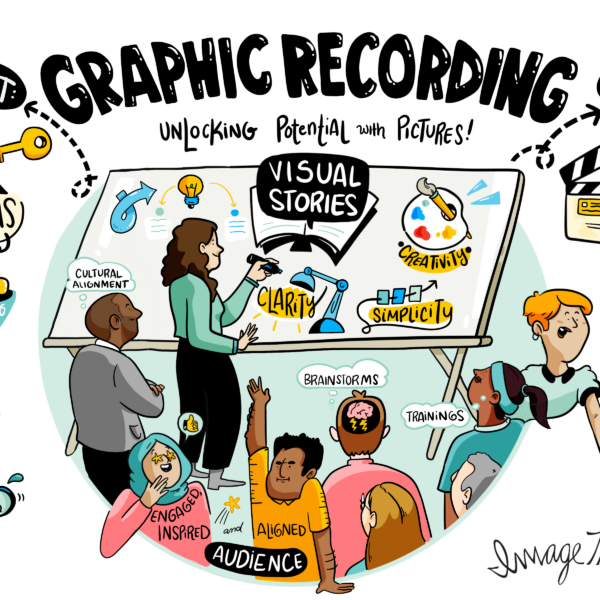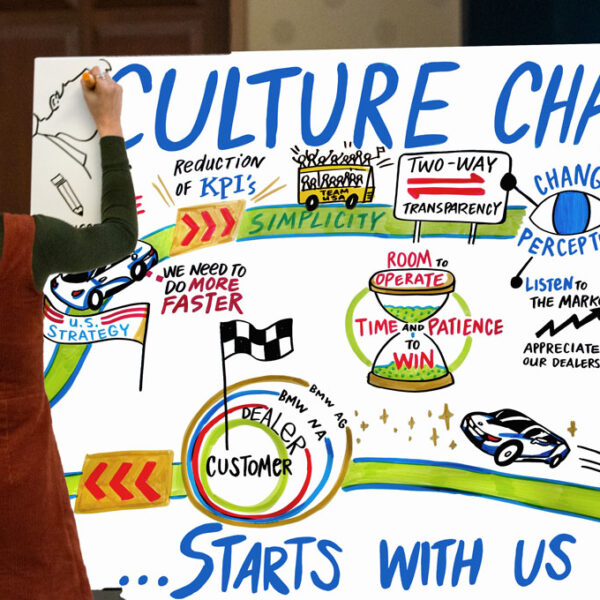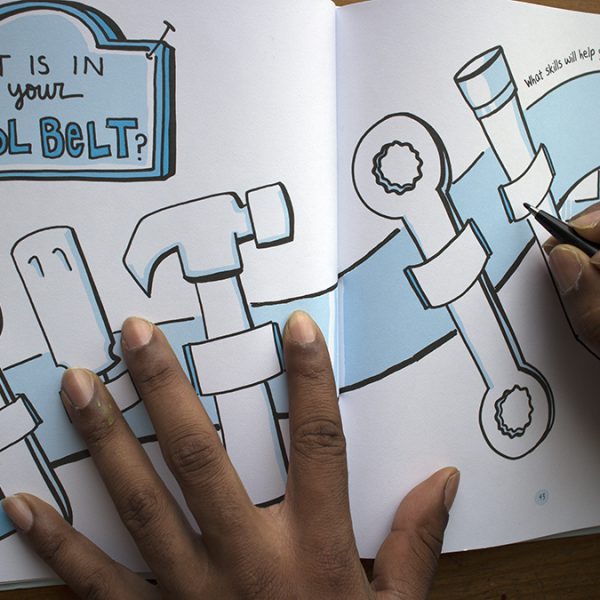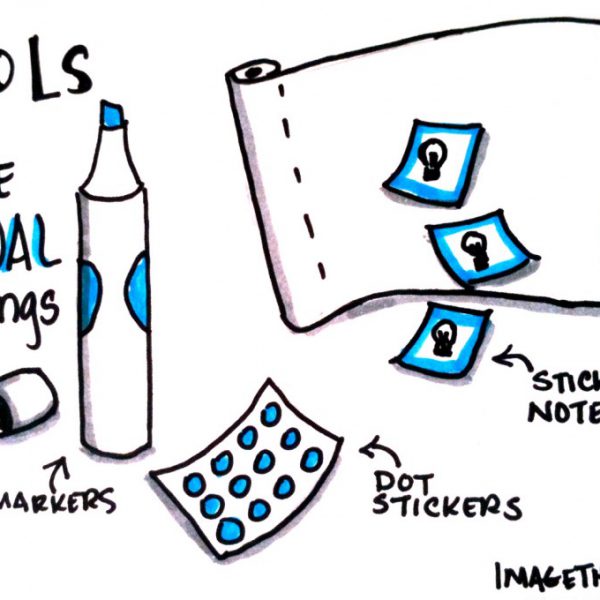Imagine a room of people with diverse backgrounds, perspectives, and ideas; all gathered to solve a problem. The air buzzes with potential, yet the path to a cohesive solution is obstructed by differing opinions, complex data, and confusion over priorities. Enter the graphic facilitator—part artist, part mediator, and full-time catalyst for clarity and creativity.
In one hand, a set of brightly colored markers; in the other, a roll of expansive, blank paper. As the meeting commences, these tools – in addition to other tangible items, visual templates and techniques – work to capture and translate information visually, build bridges between alternative viewpoints, and move teams from insight to action.
The tools in a graphic facilitator’s toolbelt are as varied as the challenges they help navigate. From markers and paper to digital tablets and virtual platforms, each piece serves a unique purpose, enabling clarity, creativity, and connection. In this blog, we’ll explore graphic facilitation tools that make real-time visual translation a powerful ally in any collaborative setting.
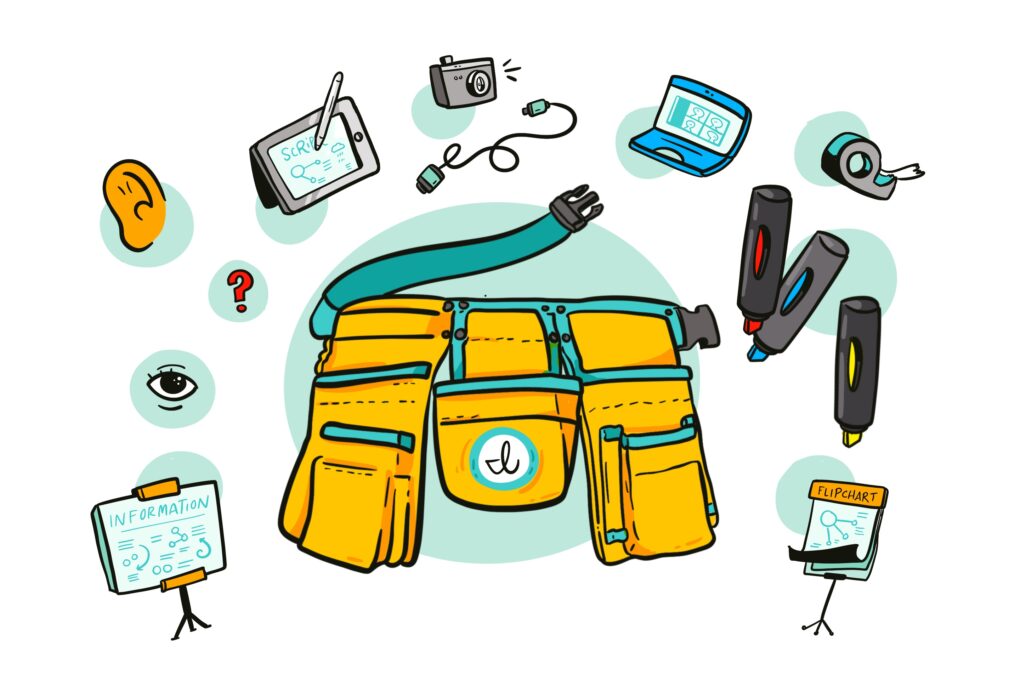
Physical graphic facilitation tools
The physical tools associated with a graphic facilitator’s role include an array of markers, mediums, and technology. These particular tools distinguish a graphic facilitator from a meeting facilitator and are essential for capturing information and enabling interaction and engagement. Graphic facilitation happens in-person, hybrid, or virtually. The meeting format largely reflects the physical tools a graphic facilitator has at their disposal.
When graphic facilitation is performed analog-style, graphic facilitators leverage markers of various colors and sizes to differentiate themes and details, and place emphasis on key points. They capture on boards, large rolls of paper, flip charts, or even enjoy the flexibility of a whiteboard. These tools enable fluid capture (or in the case of whiteboarding, adjustment) of content and discussions.
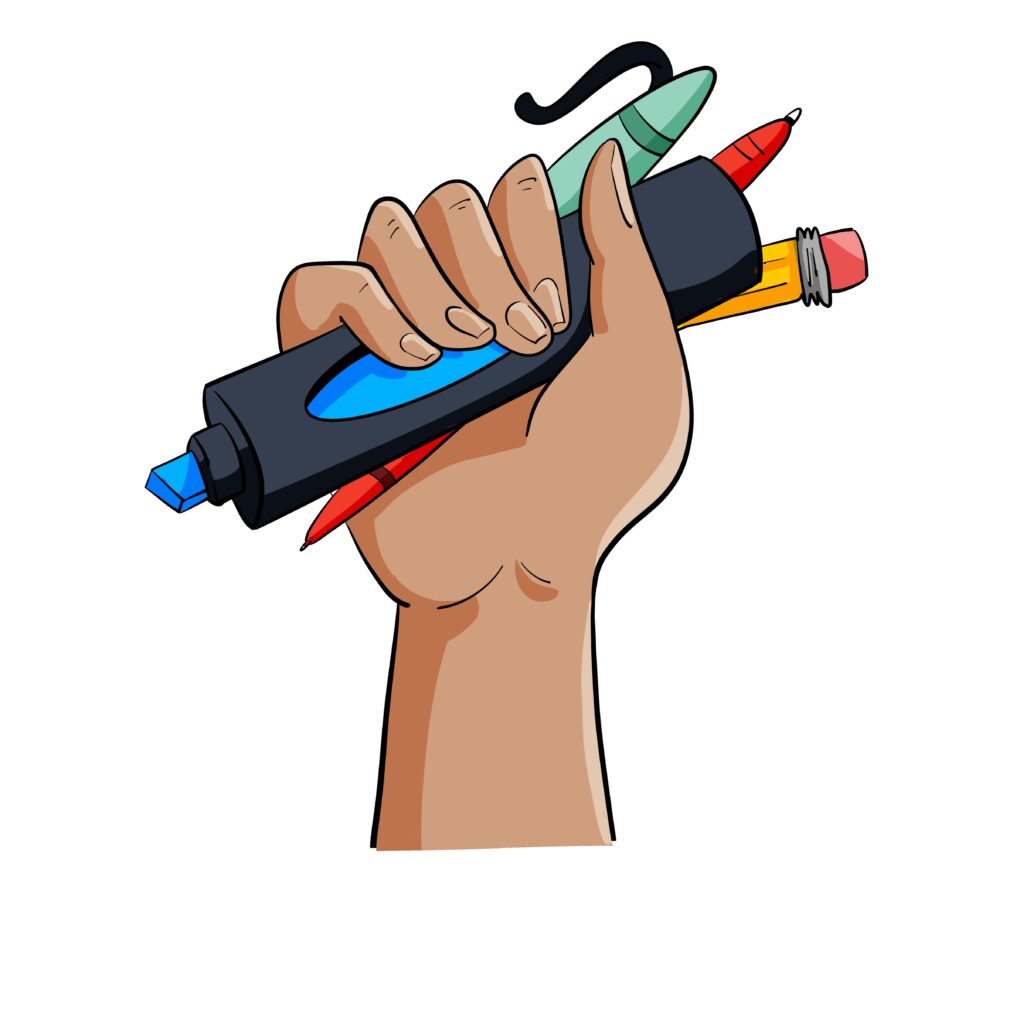
Preferrable to those holding meetings in hybrid or virtual environments, graphic facilitators can also integrate digital tools like tablets and software to produce sleek digital assets. They also leverage existing tech like projectors or cameras to extend the reach of their visual aids and ensure a connected, holistic group experience.
Intangible graphic facilitation tools
Graphic facilitators hold inherent skills that are integral to their effectiveness in their role. These tools – listening, curiosity, visual thinking, adaptability, and empathy – help lead dynamic, rewarding meetings and workshops.
The core skill of graphic facilitation is active listening. A graphic facilitator must be attuned to what is said, how it is said, and in what context. Active listening ensures that all voices in the room are acknowledged, captured, and represented equally and visually.
Curiosity and questioning are other tools that are vital for complex problem solving. A graphic facilitator must know how to frame problems or topics so as to yield the most impactful insights and will often leverage visual templates to do so. Strategic questions help probe deeper into subjects, challenge assumptions, and unlock innovative solutions and ideas.
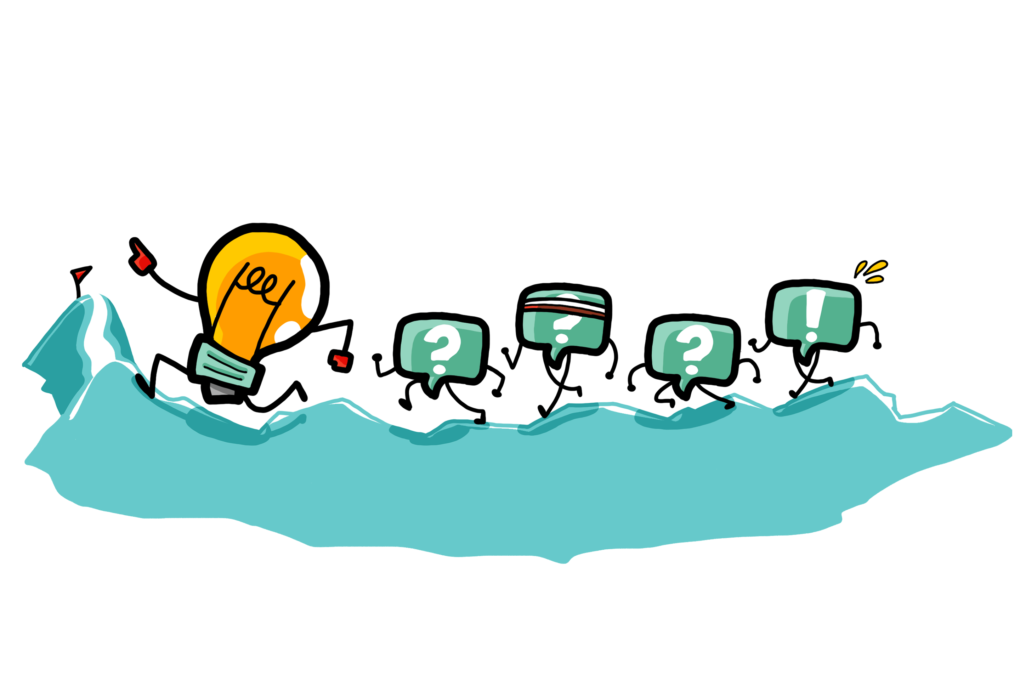
Aligned with their graphic recording abilities, graphic facilitators leverage and encourage visual thinking and working in sessions. Used to structure and navigate discussion, visual thinking helps simplify complexities and enhances communication and collaboration. Graphic facilitators use aids like creative exercises, graphic recording, and visual templates to encourage visual thinking in meetings and workshops.
Adaptability – or ninja skills, as we like to call it – is another graphic facilitation tool. This skill ensures the reading and understanding of group dynamics. It also enables graphic facilitators to adapt a session or agenda quickly, without interruption.
Finally, empathy serves as another powerful tool for graphic facilitators, enabling them to connect with participant emotions and perspectives. Through empathy, graphic facilitators create supportive environments that foster creativity and collaboration. Together, these intangible tools empower graphic facilitators to lead sessions with clarity and sensitivity.
Tools and techniques for engagement
Engagement is the cornerstone of successful meetings – crucial for maintaining energy and focus throughout a session’s duration. To build engagement, a graphic facilitator balances traditional facilitation techniques with visual strategy.
At the start of a meeting, a graphic facilitator deploys icebreakers or warm up exercises strategically. In addition to their fun nature, they also foster an open, creative environment. In particularly long sessions, when a graphic facilitator senses the energy of the group is starting to dip, they intervene with energizers. These energizers can appear in the form of visual exercises or questions and work quickly to re-focus and re-energize participants.
Graphic facilitators also leverage visual storytelling as an engagement tool. While capturing discussions and ideas, graphic facilitators create a visual narrative to help attendees connect more deeply with what they hear and experience in the room. Through visual storytelling, graphic facilitators link abstract concepts to memorable stories or visual metaphors, increasing retention, emotional impact, and engagement. These techniques make for more interactive, productive sessions.
Meeting-specific graphic facilitation tools
It might sound obvious, but often, the most effective graphic facilitation tools don’t stray far from expected meeting items. Agendas, objectives, and visual parking lots are all invaluable tools when it comes to holding a successful session.
At ImageThink, we believe an agenda is a powerful tool for ensuring session topics are covered and attendees stay on track. Visualized agendas go the extra mile for graphic facilitators, enabling flexibility and adaptability; but also maintaining participant engagement and progress toward end meeting goals.
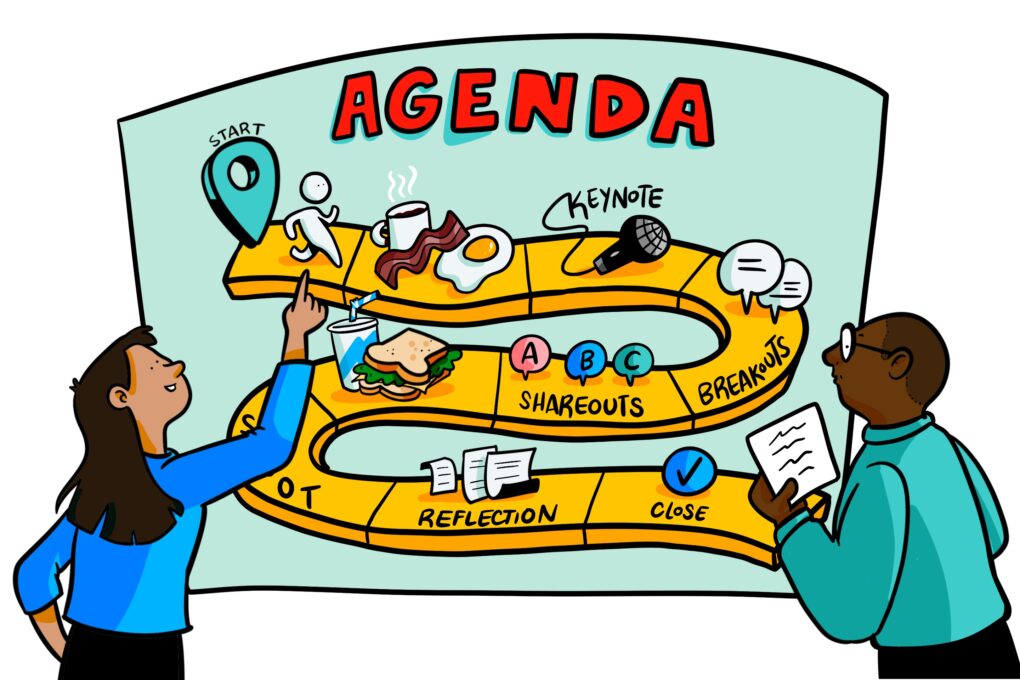
Speaking of meeting goals, clearly defined objectives are an equally important meeting-specific tool. Not only do they inform the graphic facilitator of desired outcomes, they help provide direction and prioritization of facilitator-led discussions and activities.
An innovative tool we use often at ImageThink is a visual parking lot. This tool is a designated space for “parking” ideas or issues that are off topic. This ensures that these thoughts are not dismissed but rather, that they are respectfully put aside to be revisited later. These meeting-specific tools enhance the effectiveness of a meeting by keeping it organized, focused, and productive. As a result, all discussions align with the intended outcomes.
Your unique toolbelt
ImageThink graphic facilitators recommend tailoring your toolbelt to your personal style, and more importantly, to the specific needs of your clients. This might involve selecting unique visual templates, software, or facilitation methods that align and resonate with a group’s dynamics.
New techniques, tools, and technologies continue to emerge and impact a facilitator’s role. Staying in the know about these developments is essential for remaining relevant and effective. As a graphic facilitator, committing to continuous learning – whether through workshops, courses, or self-study – is how you will ensure your tools remain sharp.
With our tools, let’s build something together
Want to avoid traditional meeting pitfalls and achieve more? Graphic facilitation can bring clarity, creativity, and connection to your next session. Get in touch with us today to explore how graphic facilitation can fit into your next strategic engagement.
